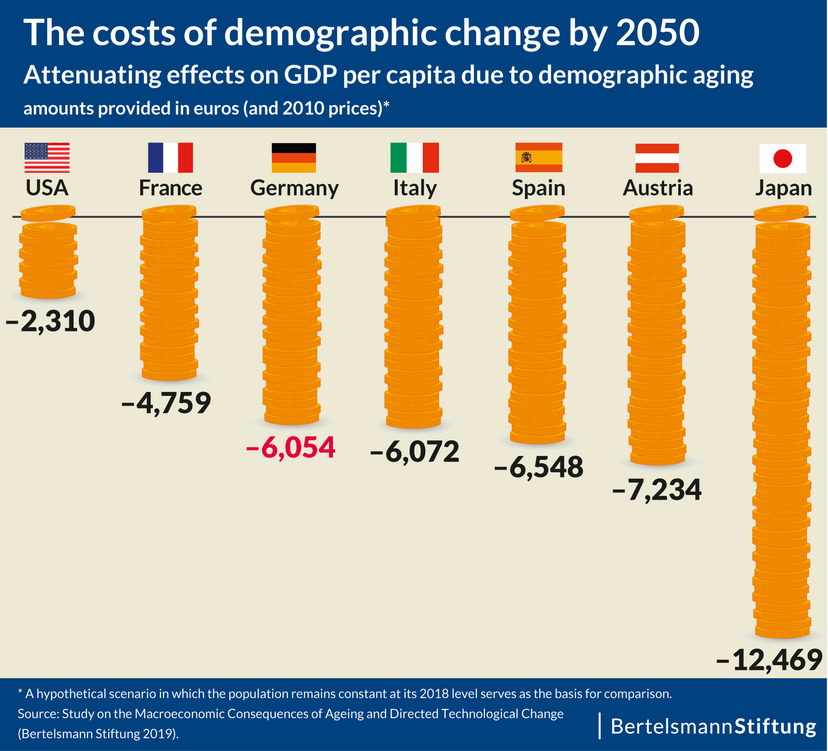In Germany, France, Italy, Japan, Spain, Austria and the United States, growth in average real per capita incomes (GDP per capita) is expected to be reduced by between €2,300 and €12,500 in 2010 prices by 2050, solely due to demographic aging and – except the USA – a lower working age population. These are the results of a study carried out by the Austrian Institute of Economic Research (WIFO) on our behalf, which calculates the consequences of demographic aging for productivity growth, economic growth and other macroeconomic key indicators in these seven countries through the year 2050.

© Free1970 - stock.adobe.com
Demographic change is leading to massive income losses in developed countries
Demographic aging will have a strong dampening effect on average incomes in Germany, France, Italy, Japan, Spain, Austria and the United States in the next 30 years. However, this effect can be mitigated by increasing investment in automation and digitalization. Our study has examined how strong the diminishing effect on individual income growth will be and how much compensatory investments would be necessary.
Greatest dampening effect in Japan, least in the USA
In 2050, demographic change will dampen average per capita income in France, Spain, Italy and Germany by €4,759 to €6,548 in 2010 prices. To calculate the income losses, the authors use a scenario as a basis for comparison in which the population is "frozen" as it is in 2018, so that the demographic change expected in the next several decades is eliminated. In Japan (€12,469), whose society has been aging rapidly since the 1980s, and in Austria (€7,234), the income-dampening effects of demographic change are even greater, the study found. The smallest demography-driven income attenuation was found in the United States (€2,310).
"The relatively good performance of the United States is primarily due to a more favorable population development that is driven by stronger immigration flows and a higher birth rate," said Martina Lizarazo López, our demographics expert who headed the study. "The United States is the only country in the sample in which the labor force continues to grow and does not age over the next 30 years."
The reason for the decrease in prosperity is that the ratio of people of working age to those of retirement age will become smaller. However, the composition of the labor force will also change. In the next 10 to 20 years, the share of older people (55 to 64 years) in the labor force will increase in nearly all of the sample's countries. Empirical research has previously shown that a person’s individual productivity reaches its maximum at about the age of 50, and slowly declines afterward. This factor has a negative effect on overall labor productivity.

Bertelsmann Stiftung
Among the seven examined countries, the USA have to fear the smallest income losses due to the aging of its society. Meanwhile, Japan would be hit the hardest. You can download this chart in the information box below.
Increased labor-market participation and investment in automation and digitalization necessary
In the countries in which the labor force will shrink in the next few decades, incentives are rising for companies to invest more heavily in so-called advanced labor-saving technologies, in order to compensate for a lack of workers and to maintain international competitiveness.
According to the study's authors, in order to offset the age-related attenuation in average per capita income by investment in information and communications technologies (ICT) and in software alone, the share of these investments in the total capital stock of these economies would have to increase significantly: In Italy, Japan and Spain, this share must go up by roughly five to six times until 2050, while in Austria, France and Germany, the corresponding share must be increased by two to three times.
"Because demographic aging has been rather moderate in the past, companies' investment decisions have been oriented toward optimizing production processes and developing new products, rather than toward implementing advanced labor-saving technologies," said WIFO's Thomas Url. "If investments in advanced technologies remain at their past levels, no positive long-term effects with regard to demographic change can be expected." However, the authors add that a comprehensive and modern digital infrastructure is required for more investment in digitalization and automation
In addition to increasing investment devoted to ICT and software, additional measures designed to bring more people into employment or to maintain individual productivity at older ages will be necessary. As Martina Lizarazo López states: "This includes improvements in education and skill levels across the entire course of life, but particularly also any company policies and employment conditions that help ensure that workers remain physically fit and healthy even at an advanced age."
Background information
The study, entitled "Macroeconomic Consequences of Ageing and Directed Technological Change," draws on the methodology employed in the EU Ageing Report. However, it expands on this by additionally considering how changes in the size and composition of the working-age population affect productivity growth and influence investment in information and communication technologies and software (as a measure of labor-saving technological progress). In addition, it calculates the effects of demographic aging on the overall economy's savings and investment rate, inflation rate, and current account balance.
The study examines the large countries of the European Union (Germany, France, Italy and Spain), Austria as an example of a small open economy, and Japan and the United States. The period investigated extends through 2050. The population forecasts used by the study correspond with current population projections produced by Eurostat and the United Nations.




